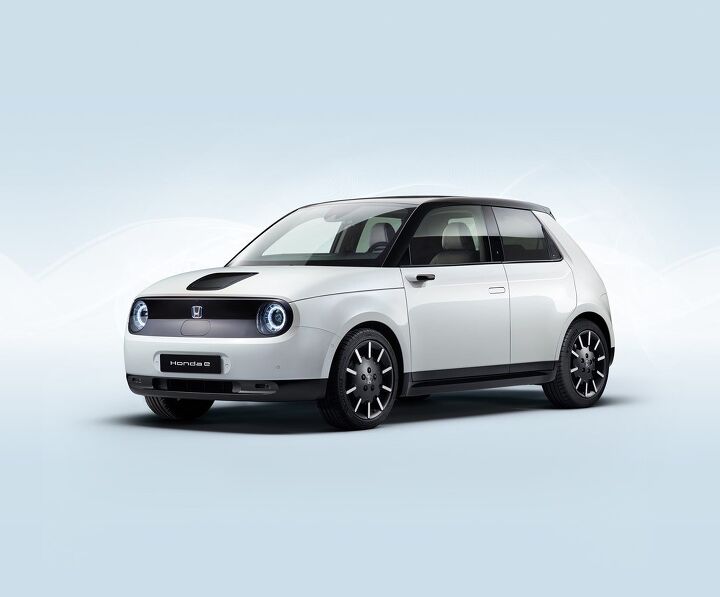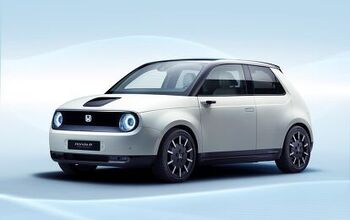Admire It From Afar: Honda Reveals Specs for the 'E'

Honda’s upcoming electric city car, destined for consumers in tightly-packed cities in Europe and Japan, has a significant fan base among online North Americans. To this group of consumers, the Honda E is the antithesis of Tesla — minus the emissions-free driving.
While the Honda E also aims to get drivers out of internal combustion cars, it goes about it in a different way. For one thing, it’s an EV fielded by a robust and profitable automaker. Sales and service should not bring a Honda buyer any worry, nor should the automaker’s balance sheet. The wee Honda aims to attract Earth-savers with modest proportions, modest price (for an EV), and modest range, with attainability and retro looks being its biggest non-ideological selling points. For all of this, the little car has earned much love from car watchers living on the wrong side of the ocean.
Ahead of its Frankfurt debut, Honda has finally revealed the E’s specifications.
Will it go faster than any car you’ve driven and feature hands-off driving that isn’t really hands-off driving? No. It is a personal commuting car, first and foremost.
The E comes in two power flavors: 134 horsepower and 152 horsepower, with 232 lb-ft of torque on tap no matter which motor you select. Sixty-two miles per hour (100 km/h) should be reached in about 8 seconds — not a screamer, but hardly a slouch.
Honda’s subcompact five-door EV makes use of a 35.5kWh battery pack for its energy reserves; given the car’s small footprint, there was only so much room for battery cells while still affording decent interior volume and cargo space. The automaker estimates range at 137 miles, which places the E slightly ahead of the Volkswagen e-Golf but behind such vehicles as the Nissan Leaf (and significantly behind every long-range EV out there, including the Hyundai Kona Electric). An 80-percent charge can be accomplished in 36 minutes at a 50 kWh plug-in, Honda claims. Dial that back to 30 minutes if you come across a 100 kWh charger.
What the E lacks in range, which Honda deems suitable for European commuting distances, it makes up for in roadgoing prowess. Boasting a perfect 50:50 weight distribution, the E routes its electric power to the rear wheels, where torque vectoring keeps the thing manageable in hard cornering. And the cornering can indeed be hard, as the battery pack affords the E a low center of gravity.
That sound you hear is eco- and cost-conscious Americans salivating at the prospect of tossing the E around on their way to work.
We’ve covered the other aspects of the E experience before — from its dual 12.3-inch touchscreens to the inclusion of the automaker’s Honda Personal Assistant service. Side cameras replace mirrors, a feature that, at least for the time being, is a no-no in the U.S.
While the E’s pricing is not yet known, Honda aims to make the car attainable for the young, urban buyers it’s already wooing. Reservations for priority ordering are already being accepted from consumers in the UK, Germany, France, and Norway. For North American customers, Honda has something else up its sleeve — a series of larger, rear-drive EVs underpinned by a new global electric architecture.
Don’t expect to get your hands on one for at least a few more years.
[Image: Honda]

More by Steph Willems
Latest Car Reviews
Read moreLatest Product Reviews
Read moreRecent Comments
- Ajla So a $10K+ transmission repair?
- Kwik_Shift_Pro4X I've mentioned before about being very underwhelmed by the Hornet for a $50000+ all in price tag. Just wasn't for me. I'd prefer a Mazda CX-5 or even a Rogue.
- MaintenanceCosts Other sources seem to think that the "electric Highlander" will be built on TNGA and that the other 3-row will be on an all-new EV-specific platform. In that case, why bother building the first one at all?
- THX1136 Two thoughts as I read through the article. 1) I really like the fins on this compared to the others. For me this is a jet while the others were propeller driven craft in appearance.2) The mention of the wider whitewalls brought to mind a vague memory. After the wider version fell out of favor I seem to remember that one could buy add-on wide whitewalls only that fit on top of the tire so the older look could be maintained. I remember they would look relatively okay until the add-on would start to ripple and bow out indicating their exact nature. Thanks for the write up, Corey. Looking forward to what's next.
- Analoggrotto It's bad enough we have to read your endless Hyundai Kia Genesis shilling, we don't want to hear actually it too. We spend good money on speakers, headphones and amplifiers!



































Comments
Join the conversation
Sure, Steph. I believe you that there's a huge pool of people who just LOVE a hypothetical Honda with the range and speed of a last-gen Nissan Leaf but just HATE Teslas. Super credible.
It would be great without that black panel on the hood.